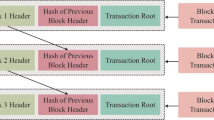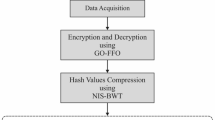Abstract
This paper proposes a learning-based model for the resource-constrained edge nodes in the blockchain-enabled Internet of Medical Things (IoMT) systems to realize efficient querying. Three layers are designed in the new model: data evaluation layer, data storage layer and data distribution layer. The data evaluation layer extracts the features from medical data and evaluates their values based on the Extreme Learning Machine (ELM) method. Then, in the data storage layer, according to the value of medical data, a novelty data structure called Merkle–Huffman tree (M-H tree) is established. Compared with the Merkle tree, high-value data (frequently accessed data) in M-H tree is saved closer to the root node and can be found faster. In the data distribution layer, the sharding-based blockchain model is adopted to increase the storage scalability of the IoMT system. Finally, the experimental results show that the new learning-based model can effectively improve the query speed of the blockchain-enabled medical system by about 3.5% and free up large amounts of storage space on IoMT devices.











Similar content being viewed by others
Availability of data and materials
The data that support the findings of this study are available on request from the corresponding author, upon reasonable request.
Notes
https://github.com/hyperledger/fabric/tree/v0.6, Dec. 2021.
References
Almogren A, Mohiuddin I, Din IU, Almajed HN, Guizani N (2021) Ftm-iomt: Fuzzy-based trust management for preventing sybil attacks in internet of medical things. IEEE Internet Things J 8(6):4485–4497
Khosravi MR, Samadi S (2021) Bl-alm: A blind scalable edge-guided reconstruction filter for smart environmental monitoring through green iomt-uav networks. IEEE Trans Green Commun Netw 5(2):727–736
Khan S, Akhunzada A (2021) A hybrid dl-driven intelligent sdn-enabled malware detection framework for internet of medical things (iomt). Comput Commun 170:209–216
Kumar R, Tripathi R (2021) Towards design and implementation of security and privacy framework for internet of medical things (iomt) by leveraging blockchain and ipfs technology. J Supercomput 77(8):7916–7955
Thakur V, Doja MN, Dwivedi YK, Ahmad T, Khadanga G (2020) Land records on blockchain for implementation of land titling in India. Int J Inf Manag 52:101940
Ali O, Ally M, Clutterbuck P, Dwivedi Y (2020) The state of play of blockchain technology in the financial services sector: A systematic literature review. Int J Inf Manag 54:102199
Sun X, Yu FR, Zhang P, Sun Z, Xie W, Peng X (2021) A survey on zero-knowledge proof in blockchain. IEEE Netw. 35(4):198–205
Chen P-C, Ja-Ling Wu T-HK (2021) A study of the applicability of ideal lattice-based fully homomorphic encryption scheme to ethereum blockchain. EEE Syst J 15(2):1528–1539
Arsyad AA, Dadkhah S, Köppen M (2018) Two-factor blockchain for traceability cacao supply chain. INCoS 2018:332–339
Hughes DL, Dwivedi YK, Misra SK, Rana NP, Raghavan V, Akella V (2019) Blockchain research, practice and policy: Applications, benefits, limitations, emerging research themes and research agenda. Int J Inf Manag 49:114–129
Qin X, Huang Y, Yang Z, Li X (2021) Lbac: A lightweight blockchain-based access control scheme for the internet of things. Inf Sci 554:222–235
El-Hindi M, Binnig C, Arasu A, Kossmann D, Ramamurthy R (2019) Blockchaindb-a shared database on blockchains. Proc VLDB Endow 12(11):1597–1609
Peng Y, Du M, Li F, Cheng R, Song D (2020) Falcondb: Blockchain-based collaborative database. In: SIGMOD Conference, pp 637–652
Schuhknecht FM, Sharma A, Dittrich J, Agrawal D (2021) chainifydb: How to get rid of your blockchain and use your dbms instead. CIDR 2021, Session 2: 1–10
Amiri MJ, Agrawal D, Abbadi AE (2021) Sharper: Sharding permissioned blockchains over network clusters. SIGMOD Conference, 76–88
Jia D, Xin J, Wang Z, Guo W, Wang G (2018) Elasticchain: Support very large blockchain by reducing data redundancy. Proc APWeb-WAIM, 440–454
Jin H, Dai X, Xiao J, Li B, Li H, Zhang Y (2021) Cross-cluster federated learning and blockchain for internet of medical things. IEEE Internet Things J 8(21):15776–15784
Dai H-N, Wu Y, Wang H, Imran M, Haider N (2021) Blockchain-empowered edge intelligence for internet of medical things against covid-19. IEEE Internet Things Mag. 4(2):34–39
Egala BS, Pradhan AK, Badarla V, Mohanty SP (2021) Fortified-chain: A blockchain-based framework for security and privacy-assured internet of medical things with effective access control. IEEE Internet Things J 8(14):11717–11731
Lin Q, Yang K, Dinh TTA, Cai Q, Chen G, Ooi BC, Ruan P, Wang S, Xie Z, Zhang M, Vandans O (2020) Forkbase: Immutable, tamper-evident storage substrate for branchable applications. ICDE 2020:1718–1721
Xu C, Zhang C, Xu J (2019) vchain: Enabling verifiable boolean range queries over blockchain databases. SIGMOD Conference 2019:141–158
Li Y, Zheng K, Yan Y, Liu Q, Zhou X (2017) Etherql: A query layer for blockchain system. DASFAA 2(2017):556–567
Jia D, Xin J, Wang Z, Lei H, Wang G (2021) Se-chain: A scalable storage and efficient retrieval model for blockchain. J Comput Sci Technol 36(3):693–706
Zhang C, Xu C, Xu J, Tang YR, Choi B (2019) Gem2-tree: A gas-efficient structure for authenticated range queries in blockchain. ICDE 2019:842–853
Zhang P, Zhou M, Zhao Q, Abusorrah A, Bamasag OO (2021) A performance-optimized consensus mechanism for consortium blockchains consisting of trust-varying nodes. IEEE Trans Netw Sci Eng 8(3):2147–2159
Hao W, Zeng J, Dai X, Xiao J, Hua Q-S, Chen H, Li K-C, Jin H (2020) Towards a trust-enhanced blockchain p2p topology for enabling fast and reliable broadcast. IEEE Trans Netw Serv Manag 17(2):904–917
Li C, Deng C, Zhou S, Zhao B, Huang G-B (2018) Conditional random mapping for effective elm feature representation. Cogn Comput 10(5):827–847
Huang G-B, Zhu Q-Y, Siew CK (2006) Extreme learning machine: Theory and applications. Neurocomputing 70(1–3):489–501
Huang G-B, Siew CK (2004) Extreme learning machine: Rbf network case. In 8th international conference on control, automation, robotics and vision, ICARCV, 1029–1036
Heijsters FACJ, van Loon GAP, Santema JMM, Mullender MG, Bouman M, de Bruijne MC, van Nassau F (2023) A usability evaluation of the perceived user friendliness, accessibility, and inclusiveness of a personalized digital care pathway tool. Int J Med Inform 175:105070
Jiang R, Xin Y, Cheng H, Wu W (2021) T-rbac model based on two-dimensional dynamic trust evaluation under medical big data. Wirel Commun Mob Comput 9957214:1–17
Huang G-B, Chen L, Siew CK (2006) Universal approximation using incremental constructive feedforward networks with random hidden nodes. IEEE Trans Neural Netw 17(4):879–892
Extreme learning machine. https://www.ntu.edu.sg/home/egbhuang/, (2020-10-27)
Poyarkov A, Drutsa A, Khalyavin A, Gusev G, Serdyukov P (2016) Boosted decision tree regression adjustment for variance reduction in online controlled experiments. In: ACM SIGKDD conference on knowledge discovery and data mining (KDD), 235–244
Chen L, Wu M, Zhou M, Liu Z, She J, Hirota K (2020) Dynamic emotion understanding in human-robot interaction based on two-layer fuzzy svr-ts model. IEEE Trans Syst Man Cybern Syst 50(2):490–501
Mishra P, Bhaya C, Pal AK, Singh AK (2020) Compressed dna coding using minimum variance huffman tree. IEEE Commun Lett 24(8):1602–1606
Funding
This work is supported by the National Key Research and Development Program of China (Grant Nos. 2021YFB3300900, 2020YFE0201100 and 2022YFB4500800), the Artificial Intelligence Technology Innovation Project of Liaoning Province (Grant No. 2023JH26/10300019), the Funds of the National Natural Science Foundation of China (Grant Nos. 92267206, 61621004, U1908213 and 62072089), the Research Fund of State Key Laboratory of Synthetical Automation for Process Industries (Grant No. 2018ZCX03), the Key Scientific Research Project of Liaoning Provincial Department of Education (Grant No. LZD202002), the Fundamental Research Funds for the Central Universities (Nos. N2116016, N2104001 and N2019007), the Open Program of Neusoft Corporation (No. NCBETOP2102), Ministry of Education Industry-University Cooperative Education Project (Grant No. 220701160215318), Program (No. JCKY2021211B017).
Author information
Authors and Affiliations
Corresponding author
Ethics declarations
Conflict of interest
The authors declare that they have no conflict of interest.
Ethical approval
This article does not contain any studies with human participants performed by any of the authors.
Rights and permissions
Springer Nature or its licensor (e.g. a society or other partner) holds exclusive rights to this article under a publishing agreement with the author(s) or other rightsholder(s); author self-archiving of the accepted manuscript version of this article is solely governed by the terms of such publishing agreement and applicable law.
About this article
Cite this article
Jia, D., Yang, G., Huang, M. et al. A learning-based efficient query model for blockchain in internet of medical things. J Supercomput (2024). https://doi.org/10.1007/s11227-024-06106-9
Accepted:
Published:
DOI: https://doi.org/10.1007/s11227-024-06106-9




